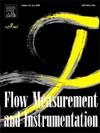An integrated approach of throttling physical model and machine learning for gas-liquid two-phase flow rates measurement
IF 2.3
3区 工程技术
Q2 ENGINEERING, MECHANICAL
引用次数: 0
Abstract
In the field of flow measurement, machine learning methods have been widely applied, and the training data used is often related to physical principles. In this study, integrating the hydraulic and thermal characteristics resulting from two-phase flow throttling, the data-physics model-based flow measurement (DPMFM) without separation for gas-liquid two-phase flow by combining throttling physical model with machine learning technique is proposed. Throttling experiments are conducted with a 12 mm nozzle. The throttling physical model is obtained through theoretical derivation and experimental data fitting. It serves as a physical constraint in the prediction model of mas quality and the basis for the calculation of flow rates. Representative features are selected as network inputs based on correlation calculation results. The performance of the model is assessed with untreated datasets and compared with the model without a physical constraint. Measurements of gas and liquid flow rates are in a good agreement with the experiments with Mean Absolute Percentage Error (MAPE) of 3.82 % and 3.62 %. The precision is favorable, with relative uncertainties for gas and liquid flow rate at 0.39 % and 0.57 %, respectively.
气液两相流量测量的节流物理模型与机器学习集成方法
在流量测量领域,机器学习方法得到了广泛的应用,所使用的训练数据往往与物理原理有关。本研究结合两相流节流产生的水力和热特性,将节流物理模型与机器学习技术相结合,提出了一种基于数据物理模型的气液两相流无分离流量测量方法。采用12mm喷嘴进行了节流实验。通过理论推导和实验数据拟合,得到了节流物理模型。它是流体质量预测模型的物理约束,也是流体流量计算的基础。根据关联计算结果选择具有代表性的特征作为网络输入。使用未经处理的数据集评估模型的性能,并与没有物理约束的模型进行比较。气液流速测量值与实验值吻合良好,平均绝对百分比误差(MAPE)分别为3.82%和3.62%。该方法的相对不确定度分别为0.39%和0.57%,精度较好。
本文章由计算机程序翻译,如有差异,请以英文原文为准。
求助全文
约1分钟内获得全文
求助全文
来源期刊

Flow Measurement and Instrumentation
工程技术-工程:机械
CiteScore
4.30
自引率
13.60%
发文量
123
审稿时长
6 months
期刊介绍:
Flow Measurement and Instrumentation is dedicated to disseminating the latest research results on all aspects of flow measurement, in both closed conduits and open channels. The design of flow measurement systems involves a wide variety of multidisciplinary activities including modelling the flow sensor, the fluid flow and the sensor/fluid interactions through the use of computation techniques; the development of advanced transducer systems and their associated signal processing and the laboratory and field assessment of the overall system under ideal and disturbed conditions.
FMI is the essential forum for critical information exchange, and contributions are particularly encouraged in the following areas of interest:
Modelling: the application of mathematical and computational modelling to the interaction of fluid dynamics with flowmeters, including flowmeter behaviour, improved flowmeter design and installation problems. Application of CAD/CAE techniques to flowmeter modelling are eligible.
Design and development: the detailed design of the flowmeter head and/or signal processing aspects of novel flowmeters. Emphasis is given to papers identifying new sensor configurations, multisensor flow measurement systems, non-intrusive flow metering techniques and the application of microelectronic techniques in smart or intelligent systems.
Calibration techniques: including descriptions of new or existing calibration facilities and techniques, calibration data from different flowmeter types, and calibration intercomparison data from different laboratories.
Installation effect data: dealing with the effects of non-ideal flow conditions on flowmeters. Papers combining a theoretical understanding of flowmeter behaviour with experimental work are particularly welcome.
 求助内容:
求助内容: 应助结果提醒方式:
应助结果提醒方式:


